Configuración del Túnel L2TP entre un Equipo Windows y un Router Cisco
Opciones de descarga
-
ePub (2.5 MB)
Visualice en diferentes aplicaciones en iPhone, iPad, Android, Sony Reader o Windows Phone -
Mobi (Kindle) (1.4 MB)
Visualice en dispositivo Kindle o aplicación Kindle en múltiples dispositivos
Lenguaje no discriminatorio
El conjunto de documentos para este producto aspira al uso de un lenguaje no discriminatorio. A los fines de esta documentación, "no discriminatorio" se refiere al lenguaje que no implica discriminación por motivos de edad, discapacidad, género, identidad de raza, identidad étnica, orientación sexual, nivel socioeconómico e interseccionalidad. Puede haber excepciones en la documentación debido al lenguaje que se encuentra ya en las interfaces de usuario del software del producto, el lenguaje utilizado en función de la documentación de la RFP o el lenguaje utilizado por un producto de terceros al que se hace referencia. Obtenga más información sobre cómo Cisco utiliza el lenguaje inclusivo.
Acerca de esta traducción
Cisco ha traducido este documento combinando la traducción automática y los recursos humanos a fin de ofrecer a nuestros usuarios en todo el mundo contenido en su propio idioma. Tenga en cuenta que incluso la mejor traducción automática podría no ser tan precisa como la proporcionada por un traductor profesional. Cisco Systems, Inc. no asume ninguna responsabilidad por la precisión de estas traducciones y recomienda remitirse siempre al documento original escrito en inglés (insertar vínculo URL).
Contenido
Introducción
Este documento describe cómo configurar un túnel L2TP (Layer 2 Tunneling Protocol) entre una máquina de Windows y un router Cisco.
Prerequisites
Requirements
Cisco recomienda que tenga conocimiento de que windows machine puede hacer ping a la dirección IP de la interfaz física en el router.
Componentes Utilizados
Este documento no tiene restricciones específicas en cuanto a versiones de software y de hardware.
The information in this document was created from the devices in a specific lab environment. All of the devices used in this document started with a cleared (default) configuration. If your network is live, make sure that you understand the potential impact of any command.
Configurar
Diagrama de la red
En este documento, se utiliza esta configuración de red:

Configuraciones
Configuración del agregador:
Se muestra un ejemplo de la configuración en el Agregador:
interface GigabitEthernet0/0/1
ip address 192.168.1.1 255.255.255.0
negotiation auto
end interface Loopback100
ip address 172.16.1.1 255.255.255.255
end vpdn enable
vpdn-group 1
! Default L2TP VPDN group
accept-dialin
protocol l2tp
virtual-template 1
no l2tp tunnel authentication interface Virtual-Template1
ip unnumbered Loopback100
peer default ip address pool test
ppp authentication chap callout
ppp ipcp dns 4.2.2.1 4.2.2.2
end ip local pool test 10.1.1.2 10.1.1.100
Configuración y configuración de Windows Machine
Complete estos pasos:
Paso 1. Abra Network and Sharing Center y haga clic en Set up a new connection or network como se muestra en esta imagen.
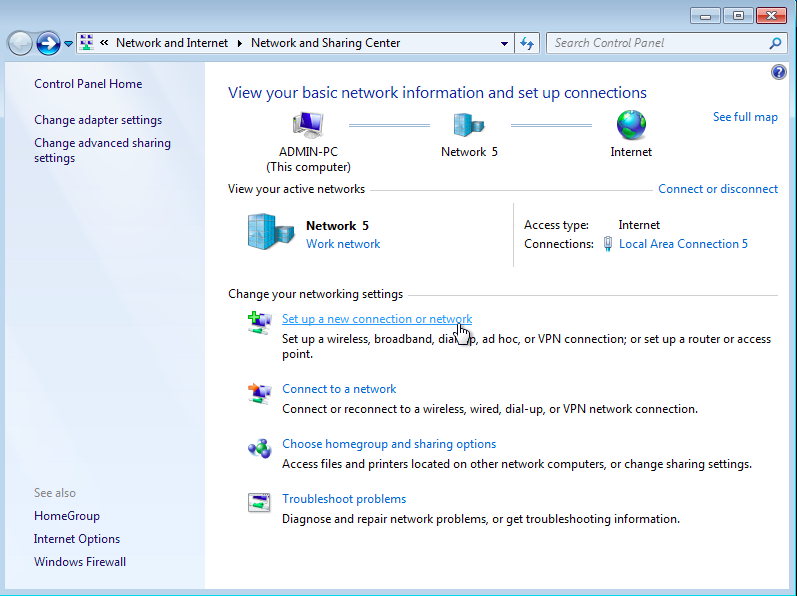
Paso 2. Seleccione Connect to a Workplace y haga clic en Next

Paso 3. Seleccione Usar mi conexión a Internet (VPN)
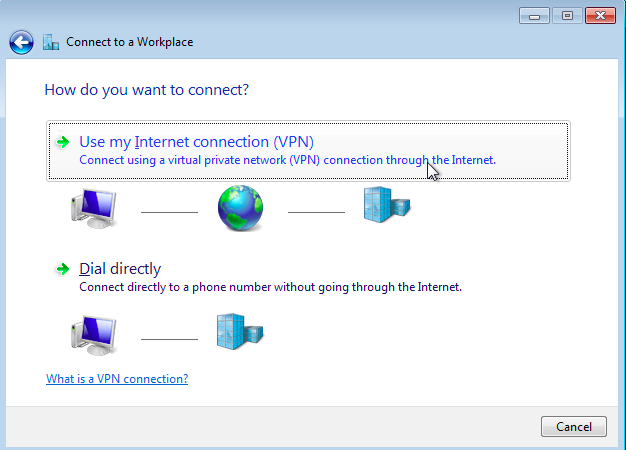
Paso 4. Introduzca la dirección IP del agregador (en este caso, 192.168.1.1), asigne un nombre a la conexión (en este caso dando el nombre como VPDN) y haga clic en Siguiente.
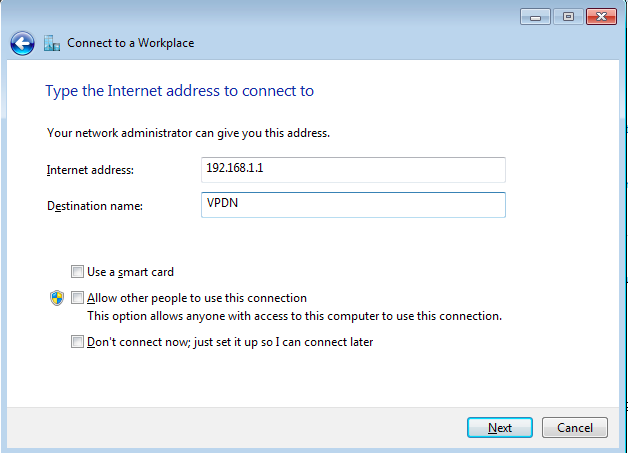
Paso 5. Introduzca el nombre de usuario y la contraseña y haga clic en Connect

Paso 6. Verifique el nombre de usuario y la contraseña
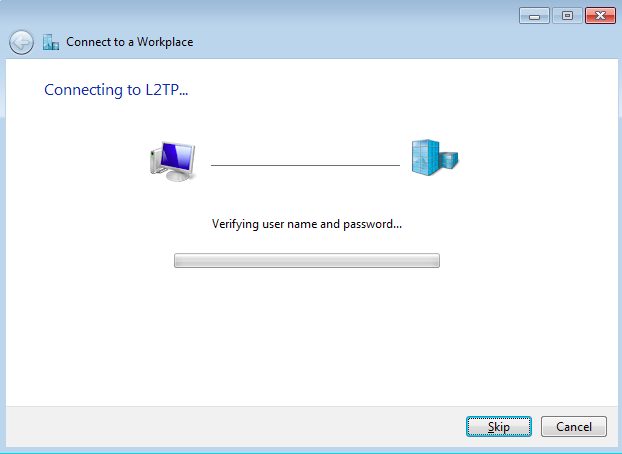
Paso 7. Podría fallar por primera vez, como se muestra en esta imagen.
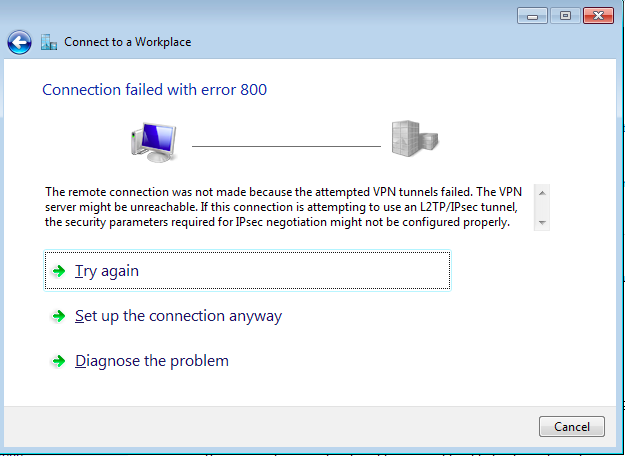
Paso 8. Haga clic en Configurar la conexión de todos modos y abra la ficha Redes.

Paso 9. Haga clic con el botón derecho del ratón en la conexión (aquí VPDN) y haga clic en Propiedades. Verifique la dirección IP del Agregador (aquí 192.168.1.1)
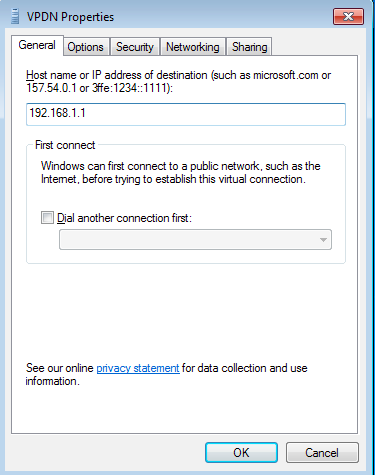
Paso 10. Navegue hasta Opciones > Configuración PPP y verifique los ajustes, como se muestra en esta imagen.

Paso 11. Navegue hasta Security >Type of VPN >Layer 2 Tunneling Protocol with IPsec, como se muestra en esta imagen.
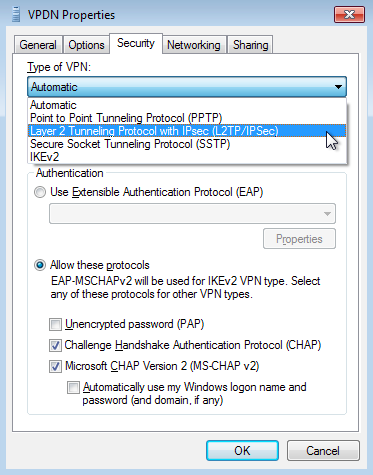
Paso 12. Seleccione la opción No encryption allowed en el menú desplegable Data encryption (Cifrado de datos):

Paso 13. Desmarque Microsoft CHAP Version 2 y haga clic en Aceptar.
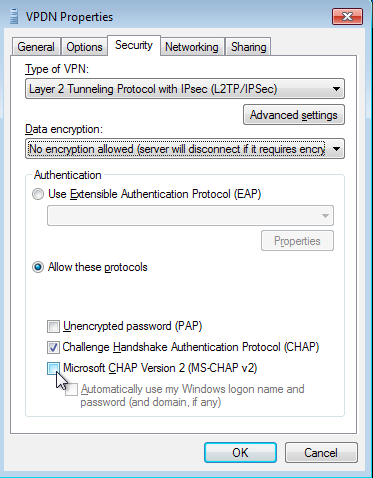
Paso 14. Abra network (aquí VPDN) y haga clic en Connect (Conectar).

Paso 15. Introduzca el nombre de usuario y la contraseña y haga clic en Conectar
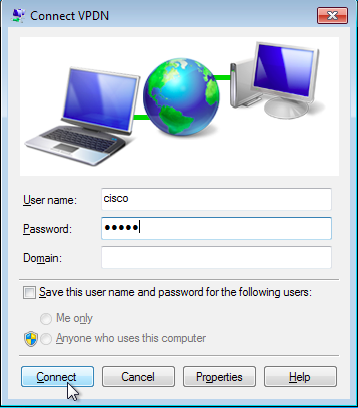
Verificación
Paso 1. Vuelva a abrir la ficha Networks, seleccione la red (denominada VPDN en este ejemplo) y verifique que el estado sea Connected (Conectado).

Paso 2. Abra el símbolo del sistema y ejecute el comando ipconfig /all.

La dirección IPv4 y el servidor de nombres de dominio (DNS) son asignados por el agregador después de completar la fase PPP Internet Protocol Control Protocol (IPCP).
Paso 3. Ejecute el comando debug ppp negotiation y los otros comandos show en Aggregator:
Aggregator#
*Apr 12 06:17:38.148: PPP: Alloc Context [38726D0C]
*Apr 12 06:17:38.148: ppp11 PPP: Phase is ESTABLISHING
*Apr 12 06:17:38.148: ppp11 PPP: Using vpn set call direction
*Apr 12 06:17:38.148: ppp11 PPP: Treating connection as a callin
*Apr 12 06:17:38.148: ppp11 PPP: Session handle[A600000B] Session id[11]
*Apr 12 06:17:38.148: ppp11 LCP: Event[OPEN] State[Initial to Starting]
*Apr 12 06:17:38.148: ppp11 PPP: No remote authentication for call-in
*Apr 12 06:17:38.148: ppp11 PPP LCP: Enter passive mode, state[Stopped]
*Apr 12 06:17:38.607: ppp11 LCP: I CONFREQ [Stopped] id 0 len 21
*Apr 12 06:17:38.607: ppp11 LCP: MRU 1400 (0x01040578)
*Apr 12 06:17:38.607: ppp11 LCP: MagicNumber 0x795C7CD1 (0x0506795C7CD1)
*Apr 12 06:17:38.607: ppp11 LCP: PFC (0x0702)
*Apr 12 06:17:38.607: ppp11 LCP: ACFC (0x0802)
*Apr 12 06:17:38.607: ppp11 LCP: Callback 6 (0x0D0306)
*Apr 12 06:17:38.608: ppp11 LCP: O CONFREQ [Stopped] id 1 len 10
*Apr 12 06:17:38.608: ppp11 LCP: MagicNumber 0xF7C3D2B9 (0x0506F7C3D2B9)
*Apr 12 06:17:38.608: ppp11 LCP: O CONFREJ [Stopped] id 0 len 7
*Apr 12 06:17:38.608: ppp11 LCP: Callback 6 (0x0D0306)
*Apr 12 06:17:38.608: ppp11 LCP: Event[Receive ConfReq-] State[Stopped to REQsent]
*Apr 12 06:17:38.615: ppp11 LCP: I CONFACK [REQsent] id 1 len 10
*Apr 12 06:17:38.615: ppp11 LCP: MagicNumber 0xF7C3D2B9 (0x0506F7C3D2B9)
*Apr 12 06:17:38.615: ppp11 LCP: Event[Receive ConfAck] State[REQsent to ACKrcvd]
*Apr 12 06:17:38.615: ppp11 LCP: I CONFREQ [ACKrcvd] id 1 len 18
*Apr 12 06:17:38.615: ppp11 LCP: MRU 1400 (0x01040578)
*Apr 12 06:17:38.615: ppp11 LCP: MagicNumber 0x795C7CD1 (0x0506795C7CD1)
*Apr 12 06:17:38.616: ppp11 LCP: PFC (0x0702)
*Apr 12 06:17:38.616: ppp11 LCP: ACFC (0x0802)
*Apr 12 06:17:38.616: ppp11 LCP: O CONFNAK [ACKrcvd] id 1 len 8
*Apr 12 06:17:38.616: ppp11 LCP: MRU 1500 (0x010405DC)
*Apr 12 06:17:38.616: ppp11 LCP: Event[Receive ConfReq-] State[ACKrcvd to ACKrcvd]
*Apr 12 06:17:38.617: ppp11 LCP: I CONFREQ [ACKrcvd] id 2 len 18
*Apr 12 06:17:38.617: ppp11 LCP: MRU 1400 (0x01040578)
*Apr 12 06:17:38.617: ppp11 LCP: MagicNumber 0x795C7CD1 (0x0506795C7CD1)
*Apr 12 06:17:38.617: ppp11 LCP: PFC (0x0702)
*Apr 12 06:17:38.617: ppp11 LCP: ACFC (0x0802)
*Apr 12 06:17:38.617: ppp11 LCP: O CONFNAK [ACKrcvd] id 2 len 8
*Apr 12 06:17:38.617: ppp11 LCP: MRU 1500 (0x010405DC)
*Apr 12 06:17:38.617: ppp11 LCP: Event[Receive ConfReq-] State[ACKrcvd to ACKrcvd]
*Apr 12 06:17:38.618: ppp11 LCP: I CONFREQ [ACKrcvd] id 3 len 18
*Apr 12 06:17:38.618: ppp11 LCP: MRU 1500 (0x010405DC)
*Apr 12 06:17:38.618: ppp11 LCP: MagicNumber 0x795C7CD1 (0x0506795C7CD1)
*Apr 12 06:17:38.618: ppp11 LCP: PFC (0x0702)
*Apr 12 06:17:38.618: ppp11 LCP: ACFC (0x0802)
*Apr 12 06:17:38.618: ppp11 LCP: O CONFACK [ACKrcvd] id 3 len 18
*Apr 12 06:17:38.618: ppp11 LCP: MRU 1500 (0x010405DC)
*Apr 12 06:17:38.618: ppp11 LCP: MagicNumber 0x795C7CD1 (0x0506795C7CD1)
*Apr 12 06:17:38.618: ppp11 LCP: PFC (0x0702)
*Apr 12 06:17:38.619: ppp11 LCP: ACFC (0x0802)
*Apr 12 06:17:38.619: ppp11 LCP: Event[Receive ConfReq+] State[ACKrcvd to Open]
*Apr 12 06:17:38.621: ppp11 LCP: I IDENTIFY [Open] id 4 len 18 magic 0x795C7CD1MSRASV5.20
*Apr 12 06:17:38.621: ppp11 LCP: I IDENTIFY [Open] id 5 len 24 magic 0x795C7CD1MSRAS-0-ADMIN-PC
*Apr 12 06:17:38.621: ppp11 LCP: I IDENTIFY [Open] id 6 len 24 magic 0x795C7CD1Z8Of(U3G.cIwR<#!
*Apr 12 06:17:38.626: ppp11 PPP: Queue IPV6CP code[1] id[7]
*Apr 12 06:17:38.626: ppp11 PPP: Queue IPCP code[1] id[8]
*Apr 12 06:17:38.640: ppp11 PPP: Phase is FORWARDING, Attempting Forward
*Apr 12 06:17:38.640: ppp11 LCP: State is Open
*Apr 12 06:17:38.657: Vi3.1 PPP: Phase is ESTABLISHING, Finish LCP
*Apr 12 06:17:38.657: Vi3.1 PPP: Phase is UP
*Apr 12 06:17:38.657: Vi3.1 IPCP: Protocol configured, start CP. state[Initial]
*Apr 12 06:17:38.657: Vi3.1 IPCP: Event[OPEN] State[Initial to Starting]
*Apr 12 06:17:38.657: Vi3.1 IPCP: O CONFREQ [Starting] id 1 len 10
*Apr 12 06:17:38.657: Vi3.1 IPCP: Address 172.16.1.1 (0x0306AC100101)
*Apr 12 06:17:38.657: Vi3.1 IPCP: Event[UP] State[Starting to REQsent]
*Apr 12 06:17:38.657: Vi3.1 PPP: Process pending ncp packets
*Apr 12 06:17:38.657: Vi3.1 IPCP: Redirect packet to Vi3.1
*Apr 12 06:17:38.657: Vi3.1 IPCP: I CONFREQ [REQsent] id 8 len 34
*Apr 12 06:17:38.657: Vi3.1 IPCP: Address 0.0.0.0 (0x030600000000)
*Apr 12 06:17:38.657: Vi3.1 IPCP: PrimaryDNS 0.0.0.0 (0x810600000000)
*Apr 12 06:17:38.657: Vi3.1 IPCP: PrimaryWINS 0.0.0.0 (0x820600000000)
*Apr 12 06:17:38.657: Vi3.1 IPCP: SecondaryDNS 0.0.0.0 (0x830600000000)
*Apr 12 06:17:38.657: Vi3.1 IPCP: SecondaryWINS 0.0.0.0 (0x840600000000)
*Apr 12 06:17:38.657: Vi3.1 IPCP AUTHOR: Done. Her address 0.0.0.0, we want 0.0.0.0
*Apr 12 06:17:38.657: Vi3.1 IPCP: Pool returned 10.1.1.9
*Apr 12 06:17:38.657: Vi3.1 IPCP: O CONFREJ [REQsent] id 8 len 16
*Apr 12 06:17:38.658: Vi3.1 IPCP: PrimaryWINS 0.0.0.0 (0x820600000000)
*Apr 12 06:17:38.658: Vi3.1 IPCP: SecondaryWINS 0.0.0.0 (0x840600000000)
*Apr 12 06:17:38.658: Vi3.1 IPCP: Event[Receive ConfReq-] State[REQsent to REQsent]
*Apr 12 06:17:38.658: Vi3.1 IPV6CP: Redirect packet to Vi3.1
*Apr 12 06:17:38.658: Vi3.1 IPV6CP: I CONFREQ [UNKNOWN] id 7 len 14
*Apr 12 06:17:38.658: Vi3.1 IPV6CP: Interface-Id F0AA:D7A4:5750:D93E (0x010AF0AAD7A45750D93E)
*Apr 12 06:17:38.658: Vi3.1 LCP: O PROTREJ [Open] id 2 len 20 protocol IPV6CP (0x0107000E010AF0AAD7A45750D93E)
*Apr 12 06:17:38.672: Vi3.1 IPCP: I CONFACK [REQsent] id 1 len 10
*Apr 12 06:17:38.672: Vi3.1 IPCP: Address 172.16.1.1 (0x0306AC100101)
*Apr 12 06:17:38.672: Vi3.1 IPCP: Event[Receive ConfAck] State[REQsent to ACKrcvd]
*Apr 12 06:17:38.672: Vi3.1 IPCP: I CONFREQ [ACKrcvd] id 9 len 22
*Apr 12 06:17:38.672: Vi3.1 IPCP: Address 0.0.0.0 (0x030600000000)
*Apr 12 06:17:38.672: Vi3.1 IPCP: PrimaryDNS 0.0.0.0 (0x810600000000)
*Apr 12 06:17:38.672: Vi3.1 IPCP: SecondaryDNS 0.0.0.0 (0x830600000000)
*Apr 12 06:17:38.672: Vi3.1 IPCP: O CONFNAK [ACKrcvd] id 9 len 22
*Apr 12 06:17:38.672: Vi3.1 IPCP: Address 10.1.1.9 (0x03060A010109)
*Apr 12 06:17:38.672: Vi3.1 IPCP: PrimaryDNS 4.2.2.1 (0x810604020201)
*Apr 12 06:17:38.672: Vi3.1 IPCP: SecondaryDNS 4.2.2.2 (0x830604020202)
*Apr 12 06:17:38.672: Vi3.1 IPCP: Event[Receive ConfReq-] State[ACKrcvd to ACKrcvd]
*Apr 12 06:17:38.747: Vi3.1 IPCP: I CONFREQ [ACKrcvd] id 10 len 22
*Apr 12 06:17:38.747: Vi3.1 IPCP: Address 10.1.1.9 (0x03060A010109)
*Apr 12 06:17:38.747: Vi3.1 IPCP: PrimaryDNS 4.2.2.1 (0x810604020201)
*Apr 12 06:17:38.747: Vi3.1 IPCP: SecondaryDNS 4.2.2.2 (0x830604020202)
*Apr 12 06:17:38.747: Vi3.1 IPCP: O CONFACK [ACKrcvd] id 10 len 22
*Apr 12 06:17:38.748: Vi3.1 IPCP: Address 10.1.1.9 (0x03060A010109)
*Apr 12 06:17:38.748: Vi3.1 IPCP: PrimaryDNS 4.2.2.1 (0x810604020201)
*Apr 12 06:17:38.748: Vi3.1 IPCP: SecondaryDNS 4.2.2.2 (0x830604020202)
*Apr 12 06:17:38.748: Vi3.1 IPCP: Event[Receive ConfReq+] State[ACKrcvd to Open]
*Apr 12 06:17:38.768: Vi3.1 IPCP: State is Open
*Apr 12 06:17:38.769: Vi3.1 Added to neighbor route AVL tree: topoid 0, address 10.1.1.9
*Apr 12 06:17:38.769: Vi3.1 IPCP: Install route to 10.1.1.9
Aggregator#show caller ip
Line User IP Address Local Number Remote Number <->
Vi3.1 - 10.1.1.9 - - in Aggregator#show ip interface brief | exclude un
Interface IP-Address OK? Method Status Protocol
GigabitEthernet0/0/1 192.168.1.1 YES manual up up
Loopback100 172.16.1.1 YES manual up up
Paso 4. Verifique si la máquina Windows puede alcanzar la red remota detrás de Aggregator (en este caso, la interfaz Loopback 100)
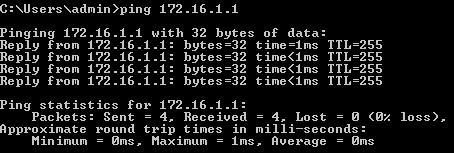
Troubleshoot
Actualmente, no hay información específica de troubleshooting disponible para esta configuración.
Información Relacionada
Con la colaboración de ingenieros de Cisco
- Utsav DuttIngeniero del TAC de Cisco
Contacte a Cisco
- Abrir un caso de soporte

- (Requiere un Cisco Service Contract)
 Comentarios
Comentarios